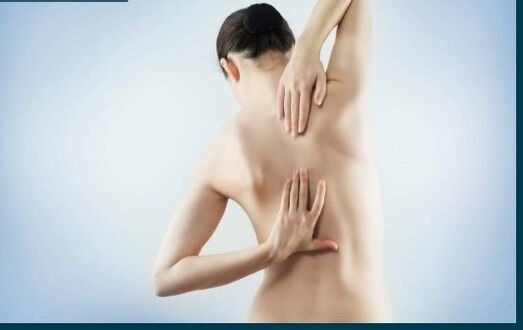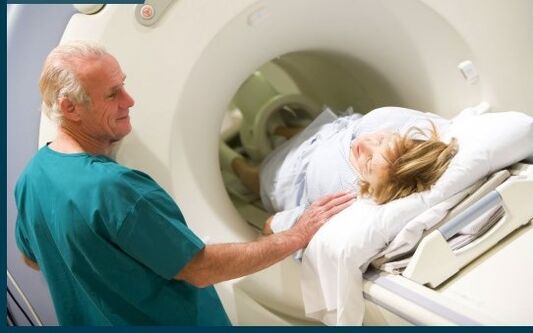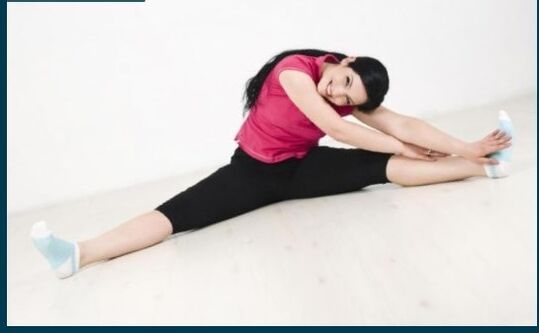Osteochondrosis of the spine is a degenerative-dystophical pathology, which is characterized by the damage to articular surfaces, intervertebral discs, muscle-light devices.The disease has a chronic course and is full of serious consequences.
The therapeutic effect of osteochondrosis is complex.The timely diagnosis of the disease is important: the sooner the therapy begins, the greater the probability of a positive result.It is almost impossible to retreat the degenerative processes, but can stop them in the debut stage.Progressive osteochondrosis can lead to bumps, intervertebral discs hernias, neurological pathologies.
General information about the disease
Osteochondrosis is the most common spinal disease and one of the most diagnosed human pathologies of all existing ones.The disease can be considered as a peculiar calculation of our type for lifting and the benefits of civilization.In animals, osteochondrosis does not have, since its spine is horizontally.
If you have periodic or regular back pain, in 75-80% of cases, these are manifestations of osteochondrosis.
In the thoracic region, degenerative changes develop less frequently than in the sacros and cervicals of the back.In general, the osteochondrosis of the thoracic region occurs after 40 years.The predisposing factors are excessive loads in the spine and a sedentary lifestyle.In the last case, blood circulation and cartilage nutrition and bone structures are altered, which leads to their gradual dystrophy.
In recent decades, doctors have noticed the general "rejuvenation" of the disease.Osteochondrosis is diagnosed even in people aged 25 to 30, which is associated with a change in the environmental state on the planet, as well as the nature of nutrition and the way of life of modern people.The presence of your own car, office work, the preference of passive relaxation on the computer is active, all these factors do not contribute to the health of the musculoskeletal system.
The danger of breast osteochondrosis (and any other) is that it is almost impossible to restore the tissues of the intervertebral discs: it means that the segments affected by distributing and degenerative transformations are condemned to a slow but inexorable destruction.The task of treatment for osteochondrosis is to stop the destruction of hard and soft tissues and minimize the risk of complications.
Characteristics of thoracic osteochondrosis
Osteochondrosis of the thoracic zone negatively affects human capacity for active movement.The progression of the disease is also loaded with pinches of the nerve endings of the spinal cord, which inevitably affects the functional status of the internal organs.In advanced clinical situations of breast osteochondrosis, it causes cardiac function, respiratory problems.
The thoracic region is distinguished by low mobility;The load is not as large as in the neck and back.The breast vertebrae anatomically connect to the ribs and the sternum and jointly represent a sedentary and strong design, protected by external damage and influences.For this reason, breast osteochondrosis is rarely manifested in the initial stage.The same circumstance determines the relative rarity of the diagnosis of "breast osteochondrosis".
The provocative factors of the disease are usually injuries, posture violations, scoliosis and other anatomical disorders.The signs of osteochondrosis of the thoracic region manifest quite late, usually in the compression stage of nerve roots.
How to manifest chest osteochondrosis
The first manifestation of the disease is the pain among the shoulder blades.The pain intensifies in charges or, on the contrary, manifests in the morning after a long stay in a position.Often, pain passes along the intercostal nerve and occurs when sneezing, coughing and running quickly.

The heart pains are possible, which resemble an attack of angina pectoris and the manifestation of heart failure.The similarity of symptoms with heart disease often leads to an erroneous diagnosis.Sometimes, symptoms resemble signs of bladder inflammation, ulcers or gastritis.To identify the true cause of pain manifestations, it is necessary to undergo a complete clinical diagnosis.
Other signs of thoracic osteochondrosis, in addition to pain:
- Neurological symptoms: a feeling of "chicken skin" in the skin in the chest and abdomen;
- Numbness of skin areas, altered sensitivity;
- Violations of the heart, pelvic organs (with the development of compression of the spinal cord);
- Intercostal neuralgia: pain in the rib area with a transition to the sternum (it develops in the form of seizures and generally causes pesos, hypothermia, stress);
- Dorsalgia: rigidity of the muscles of the case and pain during inhalation/exhalation;
- Reflex muscle tension (the body tries to reduce the symptoms of pain due to the physiological immobilization of the affected spine).
The harder the disease, the more he expressed his signs.It is important not to try to eliminate pain with analgesics and other medications, but to determine its cause by clinical methods.The car -medical for osteochondrosis in the best case makes no sense, and in the worst case it is dangerous and full of complications.
The causes of pathology
Doctors did not completely study the mechanisms that launch the tissue degeneration process.It is assumed that osteochondrosis causes an inadequate distribution of loads in the vertebrae with a weak muscle corset of the back.The circumstances that increase the probability of the disease have been clarified in detail.
The main influence factors:
- Hypodinamia (sedentary work, a tendency to passive rest);
- Excessive charges due to the birth of the activity;
- Spinal damage;
- Overweight;
- Inheritance;
- Irrational nutrition;
- Spine curvature;
- Posture violation, not composed of labor hygiene;
- Metabolic pathologies;
- Distóficos processes related to tissue;
- Constant exposure to vibration (for example, when working with a hammer cat);
- Flat feet;
- Walking with high -height shoes;
- Stress;
- Infectious diseases.
At risk of disease-attachments, motors, truckers, builders and office workers.Most of the time, the disease has a multifactorial nature: a combination of several internal and external factors leads to its development.
The generalized opinion that osteochondrosis develops due to "salts" is incorrect from a scientific point of view.The calcification of discs and cartilage really takes place with degenerative diseases of the column, but this is not the root cause, but a consequence of the pathology.
Diagnostic methods
The identification of the disease begins with the initial examination of the patient, the study of information on the symptoms, the patient's lifestyle, the nature of their nutrition and concomitant diseases.The palpation of the affected areas is carried out.

The following diagnostic procedures are prescribed:
- General and urine clinic test;
- Radiography;
- Ultrasound, MRI and CT;
- Myelography: The introduction of contrast with the spinal cord to study its structure.
The most indicative diagnostic method is x -ray.Typically, the directed radiography of specific spinal segments is performed.The images allow to identify the atrophy of the discs (reducing their thickness), the presence of osteophytes: bone growth, changes in the shape of the spine.
To exclude other pathologies with similar symptoms, consultations of cardiologists, gastroenterologists and other specialists (and relevant studies: ECG, gastroscopy) may be required.The main treatment is carried out by an orthopedist or a vertebrologist, a column specialist.
Modern therapy methods for thoracic osteochondrosis
The therapeutic effect begins with the detection of the root cause of the disease.If this is an infection, antibiotic treatment is carried out if the weakness of the muscle apparatus is carried out measures to strengthen it.More often, treatment is outpatient with the exception of situations with a difficult clinic.
The main objective of treatment is to minimize degenerative processes and their consequences.Each specific case requires the preparation of an individual treatment regime, including the effects of drugs, physiotherapeutic methods and additional rehabilitation methods.They mainly practice conservative therapy, less prescribed surgery.
Experienced doctors will never undergo treatment based on an isolated methodology or purely drug effects.Treating column diseases with pills that eliminate pain symptoms is practice without a therapeutic perspective and a sign of a non -professional approach.However, it is impossible to dispense completely without medications, especially in the acute stage of the disease.
Drug treatment
Apply the following drug groups:
- Analgesics;
- Anti -inflammatory drugs;
- Steroids;
- Musorelaxantes to relieve spasms;
- Vitamins
Preparations are mainly used in the initial stage of treatment.They stop acute pain, eliminate inflammation (if any), stimulate metabolic processes.More often, drugs are used externally (in the form of ointments), less frequently, in the form of tablets.It is even less commonly necessary to make an injection in the affected area;This method is called "novocaine block."
Physiotherapy
Physiotherapeutic methods have the main role in degenerative pathologies of the chest back.These methods eliminate pain, inflammation, restore nutrition from affected tissues.Hardware and other exposure methods are used:
- Laser treatment;
- Magnetotherapy;
- Ampulsterrapia;
- Exposure to ultrasound;
- Balneotherapy (water treatment);
- Paraffin therapy;
- Mud;
- Hypothermia - cold therapy;
- Electrophoresis and phonoforesis.
The advantage of physiotherapy in its absolute safety.This method has no contraindications for health reasons.The competent use of physical techniques provides a healing effect even in the most difficult cases.
Independent physiotherapeutic method: Therapy reflects: Effect on the body's acupuncture points.The most famous form of reflexology is acupuncture.Cauterization is also carried out, Acopress.It is demonstrated that a competent effect in certain areas launches autoalte mechanisms, eliminates pain.
Therapeutic gymnastics
Exercise therapy is a method that is used both for the treatment of osteochondrosis and for the prevention of complications.The physical exercises complex is selected individually.The purpose of exercise therapy is to reduce pressure on nerve roots, strengthen ligaments and muscles, and prevent protuberances and hernias.

Gymnastics complexes must be carried out under the guidance of a qualified instructor or strict compliance with safety rules.It is dangerous to overload the muscles, so the exercises must be accompanied by rest periods.
Manual therapy
The massage for osteochondrosis has the same objectives as physiotherapy and exercise therapy, reduces pain, improve the functionality of the ligament and muscle apparatus, and stimulate blood circulation.The competent professional massage takes over the nutrition of soft tissues and cartilage, accelerates the regeneration processes.The use of mechanical devices is allowed: applicators, electric and roller massagers.
A separate guy of manual therapy is osteopathy.The method involves a specialist in diagnostic and therapeutic manipulations of the hands.Such massage is distinguished by softness and physiological.Osteopathy eliminates tissue damage and has no age restrictions.
Diet
The main principles of diet therapy for osteochondrosis: balance, the presence of all the necessary trace elements, vitamins, a small number of calories.Another important criterion is the presence in the menu of products responsible for the synthesis of cartilage tissue in the body.These compounds are called mucopolysaccharides: the greatest number of such substances is contained in jerk, gelatin and flood dishes.
Radical therapy
In modern clinics, surgery with breast osteochondrosis resorts extremely rarely.Operations may be necessary only if complications occur in the form of persistent root syndrome.The intervention can be assigned with the development of bumps and hernias.
Prevention
It is much easier to prevent disease than performing long -term and long -term therapy.The prevention of osteochondrosis should be carried out from childhood.Degenerative processes are hindered by: adequate posture, dosage of loads in the spine, compliance with security during sports, rational nutrition, sleep on the maximum flat surface.The timely detection of the first signs of the disease and the strict implementation of the doctor's recommendations is important.



















